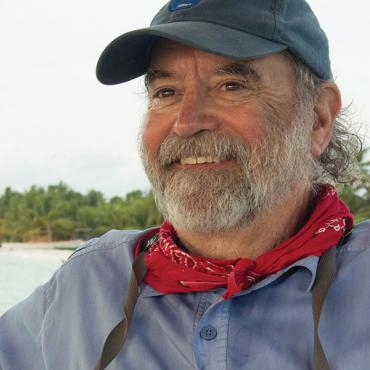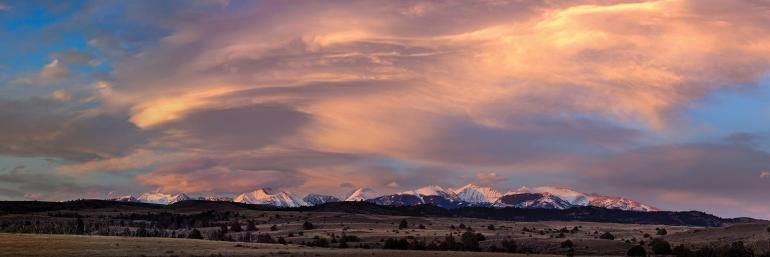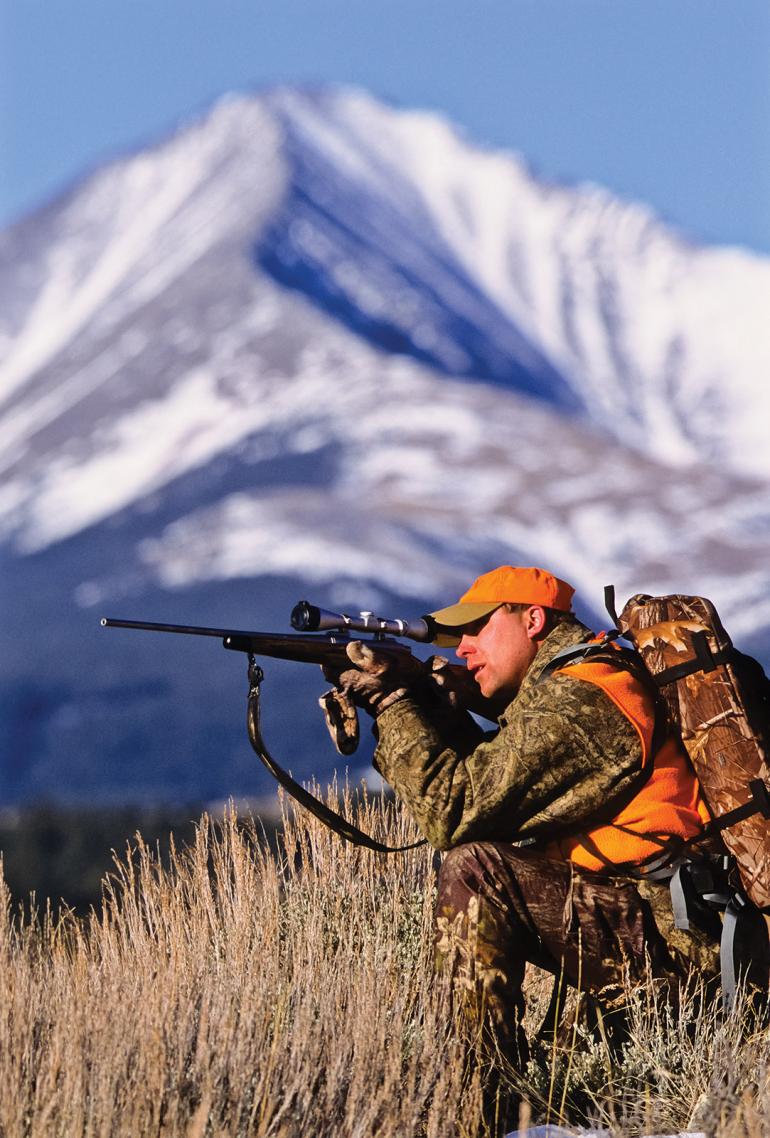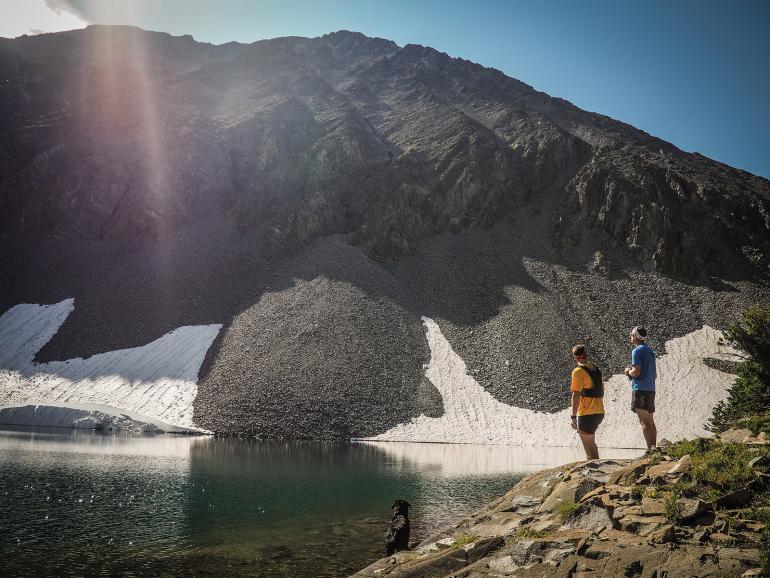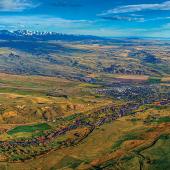Gone Crazies
Suddenly, and with dubious (possibly illegal) justification, we are losing historic public-land access. The land-transfer movement is a national trend, but the fallout is being felt close to home—most recently, in the Crazy Mountains north of Big Timber.
Menis, the first word of the Iliad, is usually translated as “rage.” While my knowledge of Greek is limited, I think “outrage” might serve even better. And if it was good enough for Homer to use at the beginning of Western literature’s cornerstone, it’s good enough for me to start with here. Everyone who cares about Montana’s wild places and their ability to enjoy public land should feel nothing short of outrage in response to recent access conflicts in the Crazy Mountains.
The Crazies are one of central Montana’s isolated “island” mountain ranges and the closest of all to Bozeman. As part of the Custer Gallatin National Forest, the heart of the Crazies lies in the public domain. However, access is limited because of private property encircling the land that belongs to all of us.
The problem is compounded by the “checkerboard” pattern of land ownership in the Crazies. During the Civil War era, the federal government began granting alternate sections of land to railroads as compensation for the expense of building track. During the 1920s, the Northern Pacific Railroad wound up with title to over 40 checkerboarded sections of land in the Crazies, many of which were eventually sold to private parties including nearby landowners. Because the legality of “corner-crossing”—stepping from one section of public land to another at a four-way corner with two sections of private land—has never been established, when recreationists reached public land in the Crazies, their legal ability to traverse the terrain remained questionable even when they never stepped onto private property.
In the 1920s, the Forest Service began building and maintaining public trails throughout the Crazies. In some cases, right-of-way across private land was negotiated formally and recorded, while in others it depended upon ongoing maintenance and historic patterns of use consistent with “unperfected prescriptive easements.” In 1948, a landowner challenged the public right-of-way on a trail running next to Big Timber Creek. The Forest Service prevailed in a legal ruling that resulted in the Big Timber Canyon Road, which now provides the only uncontested vehicle access to the east side of the Crazies.
Despite that ruling, landowners continued to challenge the public’s right to travel Forest Service trails to reach public property. The increasing value of guided trophy hunts contributed to the problem, as some landowners held permits to outfit commercially on combinations of public and private land to which they controlled exclusive access. Forest Service policy as noted in a 2002 memo was:
“It is critical for the Gallatin National Forest to have a strong and consistent policy and presence in a) signing and maintaining our trail system across private land and b) defending historic trail access rights if challenged…”
That was the situation when Alex Sienkiewicz arrived in Livingston as a National Forest District Ranger in 2011 and began addressing the access issue. Most of the conflict on the east side of the Crazies focused upon the southern end of Trail 115 (now known as Trail 136), which leads north from the Big Timber Canyon Road across a patchwork of public and private property to the Sweet Grass Creek drainage. Alerted by complaints about gates and signs denying public access, Sienkiewicz began to review records for evidence that would establish Forest Service trails’ status as public right-of-way. He didn’t have trouble finding it.
Some trails appeared on Government Land Office maps that pre-dated the Northern Pacific land grants. A 1930 letter from a Forest Service Supervisor to landowners stated: “The Forest Service is distinctly interested in keeping all existing roads open for horse travel and aggressive action will be taken in every case when trails are blocked by fencing or other manner.” A 1943 Forest Service record documented years of trail-maintenance expenses. The 1948 case involving Big Timber Canyon had established that a legal right-of-way existed along that trail. There was no evidence that the Forest Service had abandoned its interests in any of these trails. An owner of property adjacent to Trail 136 reported using the trail freely. Sweet Grass County had treated some of these roads and trails as public for purposes of gas-tax compensation from the state. And so on… The record seemed to confirm just the kind of “continuous, notorious, uninterrupted” use that legally establishes prescriptive easement absent a recorded right-of-way.
In the summer of 2016, Sienkiewicz led a group of volunteers on a day of maintenance work on Trail 136. They found new “No Trespassing” signs, evidence of trail cameras, and vandalized Forest Service markers. When hunters and others contacted him later about their ability to use the trail, Sienkiewicz restated the Forest Service position: the trail was public and open to use.
On November 23, 2016, Rob Gregoire exercised that right. Gregoire, a native Montanan and Bozeman resident, had used Trail 136 before to cross portions of the private Hailstone Ranch while scouting for elk on public land. When he returned from a brief hunt that afternoon, he found a Sweet Grass County undersheriff waiting for him. Gregoire received a misdemeanor trespassing citation that carried a $585 fine. Hunters and other concerned members of the public started a legal defense fund for Gregoire, who entered a not guilty plea in Sweet Grass County court.
Sienkiewicz had already begun to draw the ire of some large ranch owners on the east side of the Crazies. His harshest critics were a small but influential group with strong ties to the Crazy Mountains Stockgrowers Association, the Montana Farm Bureau, and the Montana Outfitters and Guides Association. The antagonism intensified when, in accordance with a policy developed in the 1990s, he continued to discourage visitors from signing in at public trailheads as some landowners demanded. The Forest Service position was that asking for permission to use these trails wasn’t necessary, and that doing so could compromise longstanding policy in the event that litigation to establish prescriptive easements became necessary. Sienkiewicz was also responding to landowner harassment of seasonal Forest Service workers as they attempted to use these trails in the performance of their duties.
His supervisors in the Forest Service initially supported him. In a 2015 letter to Montana Senator Steve Daines, Custer Gallatin National Forest Supervisor Mary Erickson wrote that she was “aware of an illegally-blocked access point” on Trail 136, and that “The Forest Service maintains it owns unperfected prescriptive rights on this trail system.”
Gregoire hoped to obviate the need for litigation to establish the public’s right to use Trail 136 when he entered his not guilty plea. But his attorneys advised that an acquittal would not establish a public easement. He also learned that the Sweet Grass County Sheriff, the Under-Sheriff who arrested him, and the county attorney prosecuting the case all had family ties along the east side of the Crazies. Petitioning for a change of venue was too cumbersome, and his counsel advised that he would not prevail in a Sweet Grass County jury trial. Winning the case would almost certainly require an appeal to district court, and given that the outcome would not establish that the trail was public, Gregoire reluctantly signed a deferred prosecution agreement.
Sweet Grass County Attorney Pat Dringham’s first offer proposed that Gregoire make $250 payments to both the Crazy Mountain Stockgrowers Association and the Montana Farm Bureau, a strange suggestion since neither group had any formal standing in the case. Gregoire wound up paying $500 to the Sweet Grass Foundation. At least he had the satisfaction of knowing he had brought the problem to attention and challenged exclusion of the public from the trail.
Landowners continued their pressure on Sienkiewicz. In May, 2017, the Policy and Environmental Research Council (PERC, one of the West’s most avid opponents of public access rights) posted a piece from Terry Andersen that called Sienkiewicz out for his advocacy of those rights. Andersen predictably framed his criticism in terms of private property rights, although there had never been a legal decision declaring the Forest Service contention of unperfected prescriptive easements invalid.
In June, 2016, Sienkiewicz circulated a routine internal memo reminding seasonal workers to avoid confrontation but refuse landowner demands that they sign in for permission to use trails the Forest Service regarded as public. Another party posted the memo on Facebook, and it eventually found its way to the Public Land and Water Access Association (PLWA) website. Sienkiewicz maintains that he was not responsible for either public posting, and review of online records confirms that position.
As a result of the now public internal memo, in January, 2017, the Montana Farm Bureau sent a letter to Montana Senator Steve Daines criticizing Sienkiewicz for “encouraging trespassing” and posting the memo “using his official title and authority,” which in fact he had not done. In May of that year, a group of private landowners wrote a letter to Daines and new Secretary of Agriculture Sonny Perdue voicing similar complaints. (The Forest Service is administered by the Department of Agriculture.) Sienkiewicz’s supporters pointed out that given the Forest Service’s position, backed by formal legal opinion, that the trails were public, he was not encouraging trespassing. Furthermore, it was by then clear that someone other than Sienkiewicz had posted the memo to both Facebook and the PLWA website.
Then the bomb dropped. On June 16, 2017, shortly after Daines and Perdue became involved in the affair, Supervisor Erickson notified Sienkiewicz that he was being reassigned to the Emigrant Crevice Locatable Mineral Withdrawal Project, the political equivalent of being sent to Puerto Rico. The announcement came with the usual bromides about Sienkiewicz being exceptionally well-qualified for his new position, but the truth came out in a subsequent statement by Erickson: “All I can share is… it relates to ongoing issues around access in the Crazy Mountains and allegations from landowners about how Alex has navigated some of these disputes…” This, despite a previous assertion that, “the Forest Service maintains that it owns unperfected prescriptive rights on this trail system”—rights that Sienkiewicz was trying to defend.
That is how matters stand at the time of this writing. Alex Sienkiewicz has been removed from his position as District Ranger and is under internal investigation for misconduct, a blot on his record no matter what the conclusion. Rob Gregoire is out the $500 the court ordered him to pay the Sweet Grass Fund, not to mention another $4,000 for gas, research, and legal fees, all because he walked up a public trail to go elk hunting. Business as usual continues on the east side of the Crazies.
There’s more than one side to every story, and in this case it’s only fair to present the landowners’ position. I had met Chuck Rein 15 years ago, when my wife, Lori, and I bowhunted goats in the Crazies, which we accessed, with permission, across land he owns. When I set out recently to interview him by telephone I anticipated some fireworks, but found him articulate, soft-spoken, and pleasant.
He pointed out that he and his neighbors have granted access permission to the public for years and expressed regret that the matter has become so contentious. However, he did not equivocate about his fundamental opinion that when no legal easement exists for a contested access, claiming otherwise is a violation of private-property rights. “I am not a legal expert,” he acknowledged, “but I do know that there is no easement unless it’s been adjudicated and recorded.”
Rein characterized recent Forest Service actions as “punitive,” and suggested that this was hurting all parties in the dispute. “We’re getting nowhere,” he said, “and we’ve got to do better. To make progress, we need to move toward an incentive-based approach.”
Those are the facts of the matter, reported as accurately as possible. Now for some editorial opinion.
The Crazies are a unique mountain ecosystem that largely consists of public land. Conflict over the public’s right to access that land via a trail system that has been in place for nearly a hundred years is not likely to end easily or soon. Rob Gregoire thought he might be able to settle matters by obtaining a not-guilty verdict on a simple trespass charge, but he proved something that most of us should realize by now: it’s not that simple. Barring some miraculous negotiated settlement, the matter will likely be resolved only by expensive litigation that will likely leave both sides at least partially disappointed in the outcome.
In a way, that’s all old news. For decades, organizations like PLWA have been using the courts—but only as a last resort—to confirm the public’s right to access land they own. The Crazies dispute represents new lyrics for what has become an old, familiar tune. While the specifics of this issue are important, they aren’t exceptional.
The outrage expressed in the opening paragraph of this piece isn’t about the inability to walk Trail 136 from Big Timber Canyon to Sweet Grass Creek without facing trespassing charges. It’s not even about the landowners, who have a right to their opinion no matter how strongly others disagree with it. It’s about the way Alex Sienkiewicz was treated by the agency supposedly responsible for guarding the public’s interest in National Forest land, and the underhanded way Washington politicians interfered with the process.
Sienkiewicz’s reassignment to an inferior position came about solely because he was doing something most of us would like to see more federal employees doing—his job. As a 2002 Forest Service briefing paper put it years before Sienkiewicz arrived: “In situations where an existing NFS trail crosses private lands, and no deeded easement exists, it is very important for the Forest and District to… take prompt action in the event that landowners threaten or take action to close or obliterate a trail.” That seems to describe just what Sienkiewicz was doing.
While landowners complained that the Forest Service had made no effort to resolve the matter in other ways, neither had they. If the status of an unperfected easement is in question, all parties have the right to settle the matter in court. Of course, there was a time when common sense and goodwill usually made such litigation unnecessary. A growing market for expensive elk hunts on public land that has effectively been privatized by access restrictions helped end that.
Efforts to penalize a Forest Service employee by exerting political pressure from Washington are deeply disturbing. In response to Freedom of Information Act requests filed by local public-lands advocate Kat QannaYahu (Enhancing Montana’s Wildlife and Habitat; emwh.org), Sienkiewicz supporters received copies of a letter from Texas Congressman Pete Sessions to Ag. Secretary Perdue, referencing the notorious email (which Sienkiewicz did not post) and requesting a directive precluding the Forest Service from pursuing prescriptive easements anywhere in the country, a threat to all Americans. Why is a Texas Congressman involving himself in a dispute about a District Ranger in Montana? Could it be because a wealthy Texan who contributes heavily to Sessions’s campaign funding owns a trophy ranch next to the Crazies? Evidently, it’s business as usual in Washington D.C., too.
It’s hard to avoid concluding that pressure from Daines and Perdue was meant to send a message: federal land managers will either do what influential local interests want or face ruined careers. Someone recently won an important election by proclaiming that it was time to “drain the swamp” in Washington D.C. Perhaps the Department of Agriculture would be a good place to start.
For now, the best Montanans can do is look to the west as they drive north on Hwy. 191 from Big Timber to Harlowton. They’ll see the east side of the Crazies from the window, and that may be the closest many of us will ever come to enjoying the public land that lies nestled within those peaks.
10/12/17 update: Alex Sienkiewicz has been reinstated to his former position as District Ranger. Read the story here.

